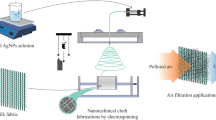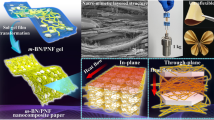Abstract
Dodecylbenzene sulfonic acid (DBSA) doped-polyaniline (PANI) coated conductive polyimide (PI) microfiber membrane was prepared by chemical oxidation polymerization. PI nanofiber membrane was prepared by solution blowing. Fourier transform infrared spectra (FTIR), X-ray photoelectron spectroscopy (XPS) and scanning electron microscope (SEM) proved that the successful preparation of composite microfiber membrane with core-shell structures. At the same time, the PANI had an effect of protection on PI nanofiber, which was detected by thermal gravimetric analysis (TGA). The orthogonal experiments were designed to determine the optimal reaction conditions for the conductivity of PANI/PI microfiber membranes as following: ANI concentration (0.15 mol L−1), APS concentration (0.1 mol L−1) and DBSA concentration (0.3 mol L−1). The conductivity of PANI/PI microfiber membranes could arrive to 3.83 × 10−2 S cm−1. Moreover, the PANI/PI microfiber membranes had a superior hexavalent chromium (Cr (VI)) adsorption performance. The factors affecting the performance of hexavalent chromium (Cr (VI)) removal from the aqueous solutions were investigated.










Similar content being viewed by others
References
Chen D, Miao Y-E, Liu T (2013) Electrically conductive polyaniline/polyimide nanofiber membranes prepared via a combination of electrospinning and subsequent in situ polymerization growth. ACS Appl Mater Interfaces 5(4):1206–1212
Lei Y, Qian X, Shen J, An X (2013) A process of applying polypyrrole-engineered pulp fibers prepared using hydrogen peroxide as oxidant to detoxification of Cr (VI)-contaminated water. Bioresour Technol 131:134–138
Yang JE, Jang I, Kim M, Baeck SH, Hwang S, Shim SE (2013) Electrochemically polymerized vine-like nanostructured polyaniline on activated carbon nanofibers for supercapacitor. Electrochim Acta 111:136–143
Xinping H, Bo G, Guibao W, Jiatong W, Chun Z (2013) A new nanocomposite: carbon cloth based polyaniline for an electrochemical supercapacitor. Electrochim Acta 111:210–215
Shimano JY, Macdiarmid AG (2001) Polyaniline, a dynamic block copolymer: key to attaining its intrinsic conductivity? Synth Met 123(2):251–262
Han MG, Cho SK, Oh SG, Im SS (2002) Preparation and characterization of polyaniline nanoparticles synthesized from DBSA micellar solution. Synth Met 126(1):53–60
Wang N, Li GD, Yu Z, Zhang XX, Qi XL (2015) Conductive polypyrrole/viscose fiber composites. Carbohydr Polym 127:332–339
Wang N, Li G, Zhang X, Qi X (2015) Chemical synthesis and characterization dodecylbenzene sulfonic acid-doped polyaniline/viscose fiber. RSC Adv 5(55):44687–44695
Yao Q, Chen L, Zhang W, Liufu S, Chen X (2010) Enhanced thermoelectric performance of single-walled carbon nanotubes/polyaniline hybrid nanocomposites. ACS Nano 4(4):2445–2451
Zhao Y, Tang G-S, Yu Z-Z, Qi J-S (2012) The effect of graphite oxide on the thermoelectric properties of polyaniline. Carbon 50(8):3064–3073
Li J, Qian X, Wang L, An X (2010) XPS characterization and percolation behavior of polyaniline-coated conductive paper. Bioresources 5(2):712–726
Peng H, Ma G, Ying W, Wang A, Huang H, Lei Z (2012) In situ synthesis of polyaniline/sodium carboxymethyl cellulose nanorods for high-performance redox supercapacitors. J Power Sources 211:40–45
Zhai G, Fan Q, Tang Y, Zhang Y, Pan D, Qin Z (2010) Conductive composite films composed of polyaniline thin layers on microporous polyacrylonitrile surfaces. Thin Solid Films 519(1):169–173
Ren JY, Huang XY, Wang N (2016) Preparation of polyaniline-coated polyacrylonitrile fiber mats and their application to Cr(VI) removal. Synth Met 222(B):255–266
Medeiros ES, Glenn GM, Klamczynski AP, Orts WJ, Mattoso LHC (2009) Solution blow spinning: a new method to produce micro- and nanofibers from polymer solutions. J Appl Polym Sci 113(4):2322–2330
Zhang L, Kopperstad P, West M, Hedin N, Fong H (2009) Generation of polymer ultrafine fibers through solution (air-) blowing. J Appl Polym Sci 114(6):3479–3486
Hasegawa M, Horie K (2001) Photophysics, photochemistry, and optical properties of polyimides. Prog Polym Sci 26(2):259–335
Liaw DJ, Wang KL, Huang YC, Lee KR, Lai JY, Ha CS (2012) Advanced polyimide materials: syntheses, physical properties and applications. Prog Polym Sci 37(7):907–974
Zhou Y, Hu X, Zhang M, Zhuo X (2013) Preparation and characterization of modified cellulose for adsorption of Cd (II), Hg (II), and acid Fuchsin from aqueous solutions. Ind Eng Chem Res 52(2):876–884
Kumar PA, Chakraborty S (2009) Fixed-bed column study for hexavalent chromium removal and recovery by short-chain polyaniline synthesized on jute fiber. J Hazard Mater 162(2–3):1086–1098
Gu H, Rapole SB, Sharma J, Huang Y, Cao D, Colorado HA, Luo Z, Haldolaarachchige N, Young DP, Walters B, Wei S, Guo Z (2012) Magnetic polyaniline nanocomposites toward toxic hexavalent chromium removal. RSC Adv 2(29):11007–11018
Zheng Y, Wang W, Huang D, Wang A (2012) Kapok fiber oriented-polyaniline nanofibers for efficient Cr(VI) removal. Chem Eng J 191:154–161
Mirmohseni A, Oladegaragoze A (2002) Detection and determination of CrVI in solution using polyaniline modified quartz crystal electrode. J Appl Polym Sci 85(13):2772–2780
Aman T, Kazi AA, Sabri MU, Bano Q (2008) Potato peels as solid waste for the removal of heavy metal copper (II) from waste water/industrial effluent. Colloids Surf B: Biointerfaces 63(1):116–121
Jiang Y, Pang H, Liao B (2009) Removal of copper (II) ions from aqueous solution by modified bagasse. J Hazard Mater 164(1):1–9
Mohammadi N, Khani H, Gupta VK, Amereh E, Agarwal S (2011) Adsorption process of methyl orange dye onto mesoporous carbon material–kinetic and thermodynamic studies. J Colloid Interface Sci 362(2):457–462
Das M, Sarkar D (2016) Effect of oxidizing agent on ammonia sensing of DBSA doped polyaniline nanocomposite thin film. J Mater Sci Mater Electron 27:4109–4119
Kumar Y, Goto T (2016) Synthesis and characterization of PANI-DBSA/DVB composite using roll-milled PANI-DBSA complex. Polymer 86:129–137
Long Y, Chen Z, Wang N, et al. (2004) Electronic transport in PANI-CSA/PANI-DBSA polyblends. Phys B Condens Matter 344:82–87
Haba Y, Segal E, Narkis M, et al. (2000) Polyaniline e DBSA/polymer blends prepared via aqueous dispersions. Synth Met 110:189–193
Araújo OA, De Paoli M-A (2009) Pilot plant scale preparation of dodecylbenzene sulfonic acid doped polyaniline in ethanol/water solution: control of doping, reduction of purification time and of residues. Synth Met 159:1968–1974
Acknowledgements
The authors are thankful to the Science Fund of Aviation (201329Q2001); National Natural Science Fund of China (21206123); Postdoctoral Program projects (2014 M551026, 201402011); Tianjin Municipal Applied Basic Research and Frontier Technology Research Programs (13JCQNJC02300) for financial support.
Author information
Authors and Affiliations
Corresponding author
Rights and permissions
About this article
Cite this article
Wang, N., Chen, Y., Ren, J. et al. Electrically conductive polyaniline/polyimide microfiber membrane prepared via a combination of solution blowing and subsequent in situ polymerization growth. J Polym Res 24, 42 (2017). https://doi.org/10.1007/s10965-017-1198-3
Received:
Accepted:
Published:
DOI: https://doi.org/10.1007/s10965-017-1198-3




